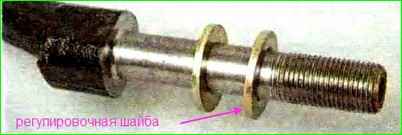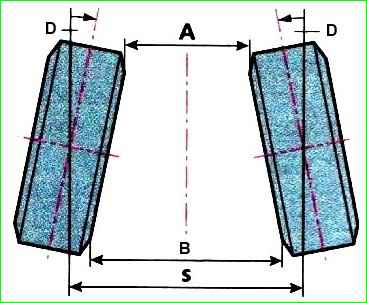To ensure good stability and controllability of the car, the front wheels are installed at certain angles relative to the body and suspension elements
Three parameters are adjusted: the caster angle of the steering axis, the wheel camber angle and the wheel toe.
The casting angle of the steering axis is the angle between the vertical and the line passing through the centers of rotation of the ball joint and the bearing of the upper support of the shock absorber strut in a plane parallel to the longitudinal axis of the vehicle.

The longitudinal inclination angle of the steering axis helps stabilize the steered wheels in the direction of straight-line motion.
Symptoms of deviation of the angle from the norm - the car pulls to the side when driving, different forces on the steering wheel in left and right turns, one-sided wear of the tire tread.
This angle is adjusted by changing the number of shims installed at both ends of the stretcher.

To increase the angle, washers are removed from the front or rear end of the stretcher, and to decrease the angle, they are additionally installed on the rear end of the stretcher (it is not always possible to install additional washers on the front end of the stretcher due to its short threaded part).
When installing or removing one shim, the caster angle of the steering axis changes by approximately 19′.
There should be no more than two adjusting washers at the front end of the extension, and no more than four at the rear end.
Camber angle is the angle between the plane of rotation of the wheel and the vertical.

The camber angle of the wheel contributes to the correct position of the rolling wheel during suspension operation.
If this angle deviates greatly from the norm, the vehicle may deviate from straight-line motion and one-sided wear of the tread may occur.
The angle is adjusted by turning the upper bolt securing the shock absorber strut to the steering knuckle while loosening the nuts of the upper and lower bolts.

Wheel toe is the angle between the plane of rotation of the wheel and the longitudinal axis of the car.
Sometimes this angle is calculated from the difference in distances between the flanges of the rims, measured from the rear and front of the wheels at the level of their centers.

Wheel toe helps ensure the correct position of the steered wheels at various vehicle speeds and turning angles.

Toe is adjusted by rotating the adjusting threaded bushings with the tie rod ends loosened.
Before adjustment, the steering rack is set to the middle position (steering wheel spokes are horizontal).
Signs of toe deviation from the norm: severe saw-tooth wear of tires in the transverse direction (even with small deviations), tire squealing when cornering, increased fuel consumption due to high rolling resistance of the front wheels (the vehicle's run-out is much less than expected).
It is recommended to check and adjust the angles of the front wheels at a service station.
Before doing this, make sure that:
- - tire pressure is normal;
- - tread wear on the left and right wheels is approximately the same;
- - there is no play in the front wheel hub bearings;
- - no play in the steering drive;
- - el suspension elements are free from deformation and destruction;
- - rubber-metal suspension joints have no wear damage;
- - wheel rims are not deformed (radial runout - no more than 0.7 mm, axial runout - no more than 1 mm).
Checking the wheel alignment angles is mandatory if suspension parts that affect these angles have been replaced or repaired.
Due to the fact that the angles of the front wheels are interconnected, first of all, check and adjust the angle of the longitudinal inclination of the steering axis, then the camber and, lastly, the toe-in.
After installing the car on the stand to control the angles, it is necessary to “press” the car’s suspension by applying force two or three times in the vertical plane to the rear and then to the front bumpers.
Front wheel alignment angles under a load of 320 kg
Front wheel camber, degrees - 0˚ 30′
Front wheel toe -1 …+1 mm
Longitudinal inclination of the wheel turning axis, degrees 1-2˚
Front wheel alignment angles for a loaded car
Front wheel camber, deg 0 -1˚
Front wheel toe-in, mm 0.5 – 2.5
Longitudinal inclination of the wheel turning axis, degrees 1 – 2˚





